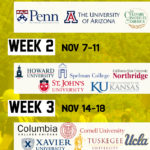The findings were released on Monday in conjunction with the kickoff to International Education Week.
By Mary Beth Marklein
University World News, 14 November 2016 —
The number of international students enrolled in United States colleges and universities topped one million last year for the first time, an annual tally says. And US students earning academic credit abroad continues to climb, though at a much slower rate of growth and in far fewer numbers.
US universities enrolled 1,043,839 foreign students last year, and 313,415 US students studied abroad in 2014-15, the latest year for which that dataset is available, according to Open Doors, released by the non-profit Institute of International Education or IIE. The report showed a similar pattern in annual rates of increase: 2.9% among US students going overseas and 7.1% among foreign students coming to the United States.

The findings were released on Monday in conjunction with the kickoff to International Education Week, a joint venture between the US State and Education departments designed to promote the importance of international education exchange.

NAFSA
An annual report by NAFSA, an association for international educators, released on Monday, has provided state-by-state details on the financial benefits of international exchange. International students come from more than 200 countries and, according to the NAFSA report, contributed about US$32.8 billion into the US economy in 2015-16 and supported more than 400,000 jobs.
And campuses around the country are marking the week with events such as lectures, exhibits and ‘passport drives’, encouraging US students to complete the necessary paperwork as a first step toward going abroad for at least part of their college years.
The annual event, launched a year before the World Trade Center attacks in 2001, falls this year just after the election of Donald Trump to the nation’s highest office. During campaigning, the president-elect called for stricter immigration laws, prompting some concerns about the fate of international exchange in a new administration.
IIE President Allan Goodman expressed concern about the directional imbalance in student flows, saying that “too few of our students study overseas”.

Goodman also emphasised US higher education’s commitment to international students, who last year represented 5% of all US university enrolments. IIE’s researchers said that reflects a slight increase over past years and attributed it in part to a decline in the numbers of domestic enrolments.
“Throughout nearly a century of surveying campuses, IIE’s Open Doors report has documented that US campuses have consistently welcomed international students from all walks of life and locations,” Goodman told University World News in a statement following the elections.
“Students choose US higher education as an investment in their future because of its high quality and diversity of opportunity, and we believe they will continue to do so.”

National Association for College Admission Counseling
Later this week, the National Association for College Admission Counseling or NACAC will launch a guide providing basic information to US students, families and counsellors about how to apply for a full undergraduate degree outside the United States. The guide – to which this author contributed – is a response to research suggesting a small, but growing interest.
NACAC also emphasised its support for cross-border educational opportunity in a statement released after the election. One of its primary policy issues focuses on college admission for undocumented students.
“Student mobility, in particular, is crucial to encouraging the many cultural, academic, diplomatic and economic benefits of cross-border education,” the statement says. “The association remains firmly opposed to policies or actions that discriminate on the basis of national origin or religion, or that otherwise infringe on fundamental human rights.”
Outgoing mobility
Advocates for international education in recent years have stepped up their focus on US students going abroad. Just 1.6% of all US undergraduates studied abroad in the 2014-15 academic year, though about 10% of US students report studying overseas at some point in their academic years.
Two years ago, IIE launched Generation Study Abroad, a national campaign aimed at helping campuses encourage study abroad. More than 700 colleges and organisations have joined the initiative.
The State Department has created a USA Study Abroad office, and this week announced a partnership with Diversity Abroad, a non-profit organisation that seeks to expand participation among minorities and low-income students.
Writing last spring in Foreign Affairs, Sanford Ungar, emeritus president of Goucher College in Baltimore, called for a “clear and forthright national education policy” encouraging students to develop global awareness by going abroad.
Ungar, who instituted a study abroad requirement while Goucher College president, told University World News that opportunities for study abroad are more important than ever as the nation transitions to a new leader.
“With the election of a president who seems likely to pursue his theme of American superiority and non-cooperation with a vengeance, it will be incumbent on the education sector to assert fundamental values more forcefully and effectively,” he said.
In a nod to the many avenues through which students can go abroad, IIE has begun tracking additional forms of education abroad, including non-credit work, internships and volunteer experience. That number reached 22,431 in 2014-15, up about 1% (from 22,181) from the previous year and 4.9% (from 15,089) from 2012-13.
Promising developments
One of the more promising developments, from IIE’s perspective, is that US students appear to be increasingly drawn to countries, including Cuba and Mexico, that the Open Doors report said “offer an up-close look at how our world is changing”. Greece saw an 18% increase – the highest rate of growth among top study abroad destinations.
One of the most troubling findings involves US study abroad to China, which has been a priority destination for the US State Department.
A goal set by President Barack Obama in 2009 to send 100,000 American students to China by 2014 was surpassed. Still, the IIE data show that the number of US students going to China dropped 7% from the previous year, to 12,790 – the third straight year of declines. Meanwhile, the numbers of Chinese students attending US colleges and universities last year increased 8% over the previous year.
The US relationship with China is both “complex” and “important strategically”, Evan M Ryan, assistant secretary of state for educational and cultural affairs at the US Department of State, had told reporters on the conference call. “We would like those numbers to be higher… We hope that this is not a long-term trend.”
Among other Open Doors’ findings:
– The US institutions drawing the most international students were New York University (15,543), University of Southern California (13,340), Arizona State University (12,751), Columbia University (12,740) and the University of Illinois at Urbana-Champaign (12,085).
– China remains the top country of origin, with almost twice the number of students in the US as India, but India’s rate of growth outpaced China’s. Enrolments from India grew 24.9%, to 165,918 students.
– Most of India’s growth occurred at the graduate level, and particularly via participation in a programme known as optional practical training or OPT, which allows foreign students to work in the United States after earning their degree.
– OPT enrolments increased 22.6% last year, while undergraduate and graduate enrolments each increased 7.1% and 6.0%, respectively. A federal rule this year lengthened the extension for OPT students in the STEM – science, technology, engineering and mathematics – fields from 17 to 24 months, and enables students to apply for an extension twice during their academic career.
– Saudi Arabia sent the third-largest number of students, 61,287, to the United States, followed by South Korea, which dropped to fourth place following a 4.2% drop in enrolments, to 61,007.
– Europe continues to host more than half of all US students going abroad, with about a third of all US students choosing the United Kingdom, Italy or Spain in the 2014-15 academic year.
– The Ebola crisis likely deterred US students from traveling to Sub-Saharan Africa; that region saw a 20% drop.
– An 18.2% drop in US enrolments from Brazil was the most dramatic decline, and was attributed primarily to the Brazilian government’s freeze on the budget of its Scientific Mobility Program, which had sponsored many Brazilian students’ US studies.










